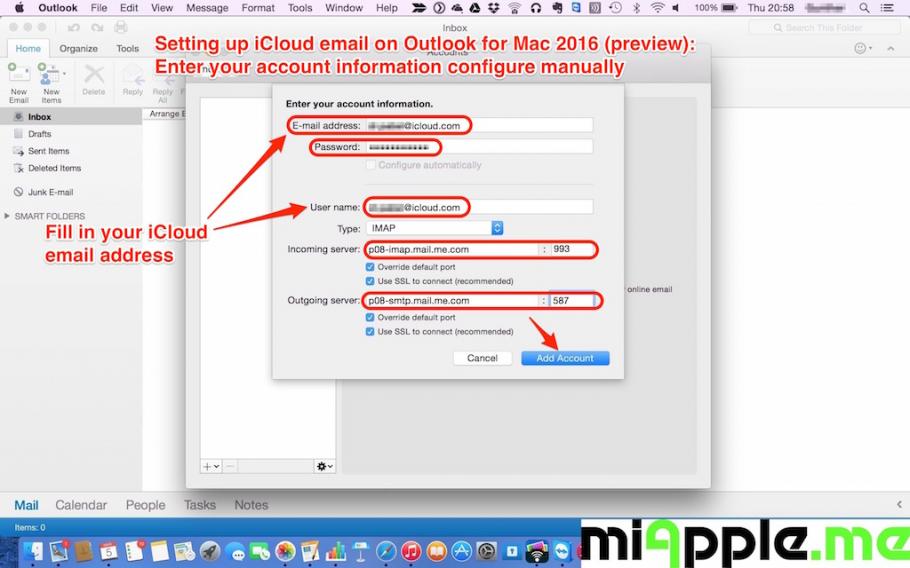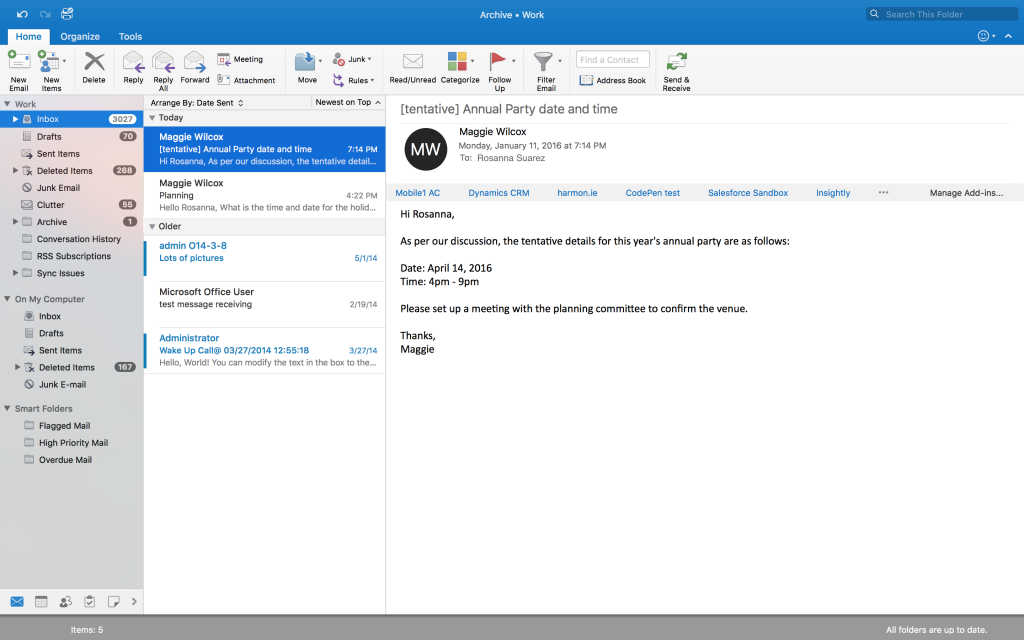

- #2016 OUTLOOK FOR MAC HOW TO#
- #2016 OUTLOOK FOR MAC FOR MAC#
- #2016 OUTLOOK FOR MAC ARCHIVE#
- #2016 OUTLOOK FOR MAC PLUS#
- #2016 OUTLOOK FOR MAC DOWNLOAD#

In the E-mail address field, enter the email address of the shared mailbox.
#2016 OUTLOOK FOR MAC PLUS#
To open the additional Exchange account, follow these steps:Ĭlick the plus sign and then click New Account to add an additional Exchange account. This method is not recognized as adding a shared mailbox, because you are adding the additional account by using its own credentials.

Use your own credentials to add an additional Exchange accountĪs an alternative to these methods, you can add another Exchange account by using additional mailboxes credentials. "Full Access" permission to a mailbox on Exchange Top-level mailbox level permission to access the top-level folder and other custom folders Level of permission to shared folder or shared mailboxįolder-level permission to the Inbox, Calendar or Address Book primary folderĪdd the mailbox under "Open these additional mailboxes" under account advanced settingsįolder-level permission to the Task and Note primary folders The following table summarizes the permissions options that may be available for a shared folder or mailbox, and the best method for opening the shared folder or mailbox based on the corresponding permission. Permissions for shared folders and mailboxes Enabling this setting is highly recommended for users who use their own credentials to access a shared mailbox. This setting was added in version 16.13.411.
#2016 OUTLOOK FOR MAC HOW TO#
Note: To see how to set up Full Access permission, see How to grant Exchange and Outlook mailbox permissions in Office 365 dedicated.Ĭhecking the setting Sync shared mailbox will allow Outlook to synchronize the shared mailbox without requiring the user to click Send/Receive. On the Tools menu, click Accounts > Advanced > Delegates.Īdd the mailbox under Open these additional mailboxes You can also use this method when you have full access permissions to a mailbox. Use this method if you are a delegate for another user's mailbox or when you have permissions to several folders in a shared mailbox. You are a delegate for another user's mailbox The shared folder appears in the navigation pane under the Shared heading. On the Type pop-up menu, click Calendar, Address Book, or Inbox, and then click OK. If you have multiple Microsoft Exchange accounts, on the Account pop-up menu, click the account that you want to use to open the other user's folder.
#2016 OUTLOOK FOR MAC DOWNLOAD#
The links below will download the last production-ready 15.xx version of the app (s). 1.In Safari, re-download the Office app or apps you just deleted.
#2016 OUTLOOK FOR MAC FOR MAC#
Install the latest 15.xx version of Office for Mac 2016. Type the name of the person who granted you access, click Find, click the person's name, and then click OK. To do this, open Outlook and go to File > Export and then follow the steps above. On the File menu, point to Open, and then click Other User's Folder. If another user has shared an inbox, primary calendar folder, or primary contact folder with you, use this method to open the user's folder.

Outlook for Mac does not support Auto-mapping of shared mailboxes. If you do not have "Send As" or "Send On Behalf of" permissions for the account, email from the account will not be sent. To begin archiving your email, click the. Archiving email can help you keep your emails organized, making it easier to find older emails and to keep your Inbox and folders uncluttered.
#2016 OUTLOOK FOR MAC ARCHIVE#
This lets you select the account in the From field regardless of whether you have permissions to send from this account. How to archive email in Outlook 2016 for Mac. If the resource owner has granted you viewing or editing permissions, you can open the resource's calendar in the same way that you'd view a shared personal calendar.When you use any of these methods, the shared mailbox account is added as an option in the From field when you compose emails. In order to view a Resource Account's calendar directly, like you'd view your own calendar, the owner (or someone delegated by the owner) must give you access permissions. The default setting is that anyone can see a resource's free/busy status by using the Scheduling tab to set up an event. See the Calendar for a Resource that Has Been Shared With You See our View Resource Accounts in Outlook 2016 for Mac article. See the Calendar for a Resource where You Have Access Rights Resource Accounts do not allow scheduling conflicts that is, if the resource already has an event scheduled for a particular time, no one else can "invite" the resource to another event. Once you've added the resource to your invitation, review its free/busy time on the Scheduling tab, just like you would for the people you've invited. When creating a meeting proposal, "invite" the resource by adding them the same way you would add a person. However, the owner can change this so that, when someone includes the resource as an invitee to a meeting, the owner (or someone delegated by the owner) approves or denies the request. The default setting is that anyone using Exchange Calendar can schedule a resource.


 0 kommentar(er)
0 kommentar(er)
